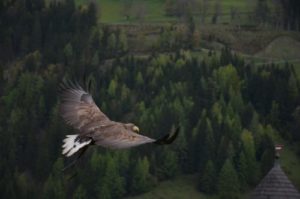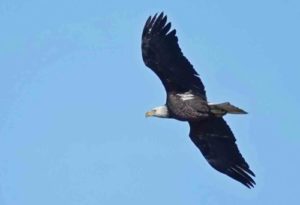
by Patressa Kearns
Great news for birdwatchers: During the 10 weeks between September 15 and November 30, it’s nearly impossible not to see birds of prey, or raptors, flying over Shenandoah National Park! This is because the Appalachian Mountains, the chain of which the Blue Ridge Mountains are a link, serve as a key corridor for hawks, eagles, and other raptors migrating to South America for the winter. Shenandoah National Park is essentially an air lane for southerly-moving raptors.
One raptor you’re sure to see in Shenandoah is the broad-winged hawk. From summer into late November, broad-wingeds “kettle” in the skies above the Park by the hundreds. Kettling is a raptor’s way of conserving energy: While migrating, large groups of broad-winged hawks catch a thermal – a column of rising warm air – and ride it (much like air surfing), little by little losing altitude but always moving farther south. The birds ride one thermal until, as a group, they find another. They will rise with the new thermal and ride it for as long as they can. The group of birds repeats this “thermal hunt” – up and down again, up again and down – all the way to their South American destination, covering an average of 69 miles per day. In this way, the birds have to flap their wings very little, which amounts to a great conservation of energy.
After breeding throughout eastern North American in the warm months, broad-wingeds must fly south an average of 4,350 miles each fall and back north again each spring. That’s a lot of flying! Broad-winged hawks and other raptors are wise to make use of thermals and kettling as much as they can.
At least 25,000 broad-winged hawks migrate over Shenandoah National Park each autumn, most passing through in the 10 days between September 15th and 25th. But look for broad-winged hawks and other raptors in Shenandoah anytime between mid-September and the end of November, with overall peak raptor migration occurring between mid-September and mid-October.

Though broad-winged hawks are among the most common raptors that migrate through Shenandoah, 13 other species also make use of the Appalachian migration corridor in fall, sharp-shinned hawks, Cooper’s hawks, red-tailed hawks, bald eagles and golden eagles among them. American kestrels (small birds in relation to most raptors), peregrine falcons, northern harriers, and others fly south through Shenandoah, too.
Rockfish Gap Hawk Watch
A great place to hawk-watch is Rockfish Gap, where Shenandoah National Park’s Skyline Drive meets the Blue Ridge Parkway. More than 20,000 raptors migrate through Rockfish Gap each fall; you might see as many as 10,000 hawks in a single day!
A small cluster of local birdwatching volunteers known as Rockfish Gap Hawk Watch heads up a migrating hawk count each autumn at Rockfish Gap from August 15 to November 30. And visitors are welcome! Rockfish Gap Hawk Watch is one of over 200 hawk watch sites in North America monitored by the Hawk Migration Association of North America (HMANA).
For more information on how you can be part of the fall raptor migration count visit Rockfish Gap Hawk Watch’s website. Don’t miss your chance to witness the amazing natural spectacle of raptor migration in Shenandoah!